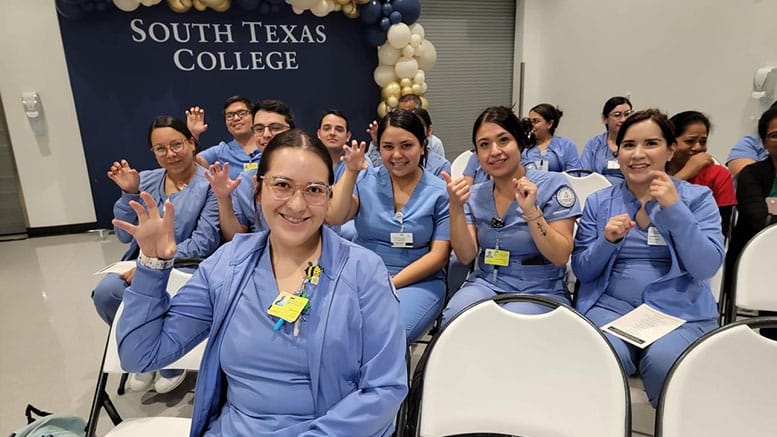South Texas College (STC), with its five campuses and two learning centers dotting the map along the Rio Grande in the rural southern tip of the state, has become the first college in the country to be certified by the U.S Department of Labor (DOL) for its nursing apprenticeship program.
The program, part of the college’s thriving Division of Nursing and Allied Health, which enrolls 1,100 largely first-generation students, will allow about 20 students next fall to earn at least $14 an hour while they get one-on-one rotations with nurse mentors in clinical experiences as part of their two-year associate degree in nursing (ADN).
“This partner apprenticeship program is a practical, sustainable solution to address the nursing shortage in our community, but, hopefully, this also will be an example and a national model for others to follow,” said Jayson Valerio, dean of the division, who noted that there is a critical, growing shortage of nurses nationally and in his region, where STC estimates that 11% of nursing positions now are unfilled.
An important recognition
“The designation for South Texas by the Labor Department is huge,” said Rick García, CEO of the Organization for Associate Degree Nursing (OADN), an affiliate council of the American Association of Community Colleges. “It is a significant win for the college and the community college system, which is such a critical part of nursing education and the nursing profession.”
He noted that such paid apprenticeships provide financial support that is crucial to nursing students often struggling to fit work, a rigorous nursing academic program and life commitments into their schedule.
“Too often, community colleges have not been recognized for the work they do for their students and in the communities they serve day in and day out,” Garcia added. “Nursing is one of the areas where that is the case. This puts a spotlight on and supports a program that is providing high-quality nursing education and training to a healthcare sector where it is critically needed.”
The Texas Workforce Commission, which collaborated with STC on the 17-month effort to obtain the first-in-the-nation designation and the accompanying $3 million DOL grant, estimates that over the next decade the state is going to face a gap of about 57,000 nurses.
Benefiting the profession
Valerio also noted that the American Nurses Association (ANA) has found that 18% of new registered nurses leave the profession within a year.
“By immersing nursing students in a clinical environment along with the STC associate degree in nursing curriculum, the program aims to acculturate them to the hospital’s practices and values,” he said.
That approach should increase nurse staffing satisfaction and retention, he continued, adding that the program will focus on “enhancing newly licensed nurses’ onboarding and orientation process” and create “a seamless transition for nursing graduates into their professional roles.”
Valerio said participating healthcare facilities will benefit because nursing students will become well-acquainted with hospital procedures and the patient population.
“That clinical readiness will contribute to their own professional development but also benefit the hospital by reducing the time and resources required for orientation of new nursing staff while integrating newly licensed nurses into the hospital’s system and potentially providing better patient care and safety,” he said.
“This is the right place to make an investment that is going to yield the highest dividends that you could ever imagine,” Rose Benavidez, chair of the STC board, said at a recent ceremony highlighting the designation.
Valerio noted that STC worked closely with DHR Health to develop standards for the apprenticeships, and the large healthcare system is providing one-to-one support.
“The RN [registered nursing] mentors in DHR Health are central to the success of the program. The goal of each RN mentor is to clinically educate and guide one nursing student throughout their associate degree in nursing journey, from day one until the student completes their degree,” he says, noting that both DHR and the college made training and developing the mentors a priority, which benefits the apprenticeship program along with nursing at DHR.
Additional gains
The STC’s nursing and allied health division also has received a sizeable portion of a $3 million DOL grant to enhance simulation technology and a $2 million grant from Hidalgo County to improve faculty salaries in order to retain strong educators and attract others, Valerio said. He noted that the nursing faculty vacancy rate nationally is 8.8%, with some 2,270 positions open.
“This should enhance the attractiveness of academic positions and incentivize experienced nurses to consider teaching roles,” Valerio said. “By helping to close the compensation gap and offering additional stipends, STC aims to make academic positions more attractive and competitive compared to clinical and private sector roles.”

The apprenticeships will initially be completed with DHR, which serves the region at more than 60 locations. Students will get 2,000 hours of clinical education, working with nurse mentors throughout the academic year. Additionally, they will complete 430 hours of classroom time, Valerio explained.
They will graduate with an ADN and become eligible to sit for the National Council Licensure Examination-Registered Nurse, a prerequisite for obtaining an RN license in most states, he said.
“Our apprentices will be placed in a hospital, get assigned a nurse preceptor who will mentor them and will be a guaranteed job,” Valerio said. “Because the student will be acclimated to that hospital setting, it will minimize the onboarding period. They’ll be ready to hit the ground running. This really is a win-win for everyone involved.”
He said he hopes to enroll 20 students in the program initially this coming academic year but can foresee enrollment growing to 80.
Filling a role
García added that apprenticeships “bridge the gap between theory and practice” and are growing in popularity among community college nursing programs. He says along with retention of nurses and nursing educators, such training opportunities are a top priority for OADN.
“Additionally, the apprenticeship provides financial support, which is crucial to a nursing student,” he said. “Currently, many students are employed in a healthcare setting and trying to meet the academic rigor of a nursing program, which can create many challenges for them. The apprenticeship program is an excellent solution to provide paid clinical experience that meets the academic requirements.”
Community colleges have long been a critical link in nursing education, and apprenticeships are a logical enhancement of that role and are taking shape in a variety of forms, Garcia said. Although not classified as a DOL apprenticeship program, some healthcare facilities employ students in their last semester of nursing clinicals, for example, and provide them academic credit in exchange for the nursing graduate to work there for one year.
“Community colleges, as crucial players in associate degree nursing education, are actively embracing and implementing these programs,” he said. “They collaborate with local healthcare providers to establish partnerships that align academic curricula with the evolving demands of the healthcare sector.”

